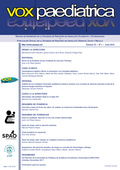![]()
Asma de riesgo vital en atención primaria
El asma es la enfermedad crónica más prevalente de la infancia, con un pequeño porcentaje de formas graves, cuyo control es más difícil e incluso pone en riesgo la vida del paciente. Los conceptos de asma grave, de control difícil y de riesgo vital, están interrelacionados, pero no son sinónimos entre sí. El pediatra de Atención Primaria, primer eslabón asistencial, debe no solo diagnosticar el asma, establecer su gravedad e indicar y ajustar el tratamiento sino también participar en la educación de los pacientes y hacer una correcta derivación de aquellos que lo precisen. Dado que cualquier asmático puede llegar a tener un asma de riesgo vital, es esencial que el pediatra de Atención Primaria sea capaz de hacer un correcto seguimiento de los niños con asma. Esto implica conocer también los factores de riesgo asociados más frecuentemente al asma de riesgo vital, tanto los relacionados con los servicios sanitarios, como con el paciente y su entorno y la propia enfermedad. Un profundo conocimiento de estos aspectos le permitirá identificar adecuadamente a quienes deban etiquetarse como de probable asma de riesgo vital y actuar en consecuencia.
Asthma is the most prevalent chronic disease of childhood, with a small percentage of severe forms, with more difficult control and even puts the patient’s life at risk. The concepts of severe asthma, difficult control and vital risk, are interrelated, but are not synonymous with each other. The Primary Care pediatrician, the first healthcare link, must not only diagnose asthma, establish its severity and indicate and adjust the treatment, but also participate in the education of patients and make a correct referral. Given that any asthmatic can have a life-threatening asthma, it is essential that the Primary Care pediatrician is able to correctly monitor children with asthma. This also involves knowing the risk factors most frequently associated with life-threatening asthma, both those related to health services, as well as to the patient and their environment and the disease itself. A deep knowledge of these aspects will allow to properly identify those who are likely to have life-threatening asthma.
| Adjunto | Tamaño |
|---|---|
| vox_paediatr_2018_25_41-49_.pdf | 243.6 KB |



